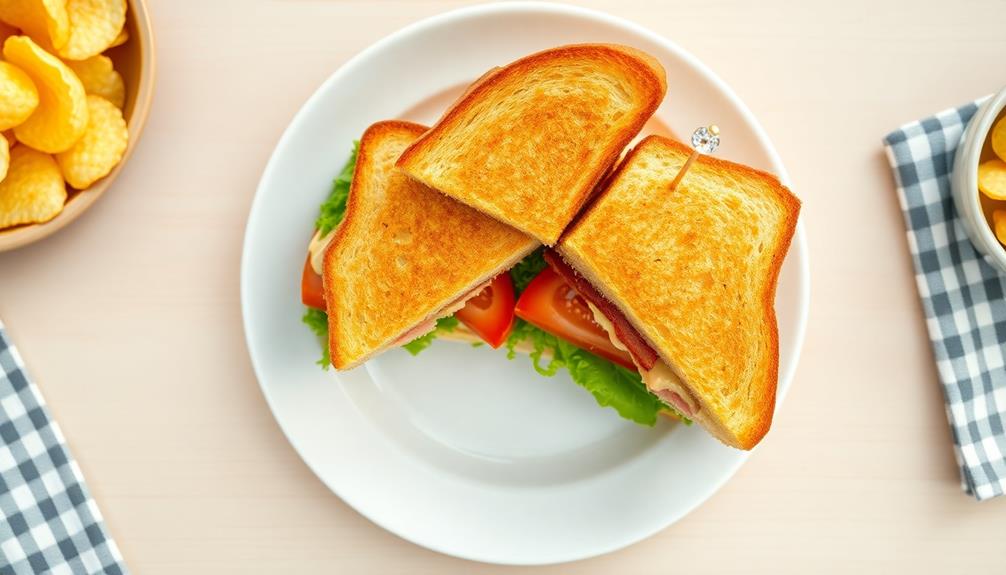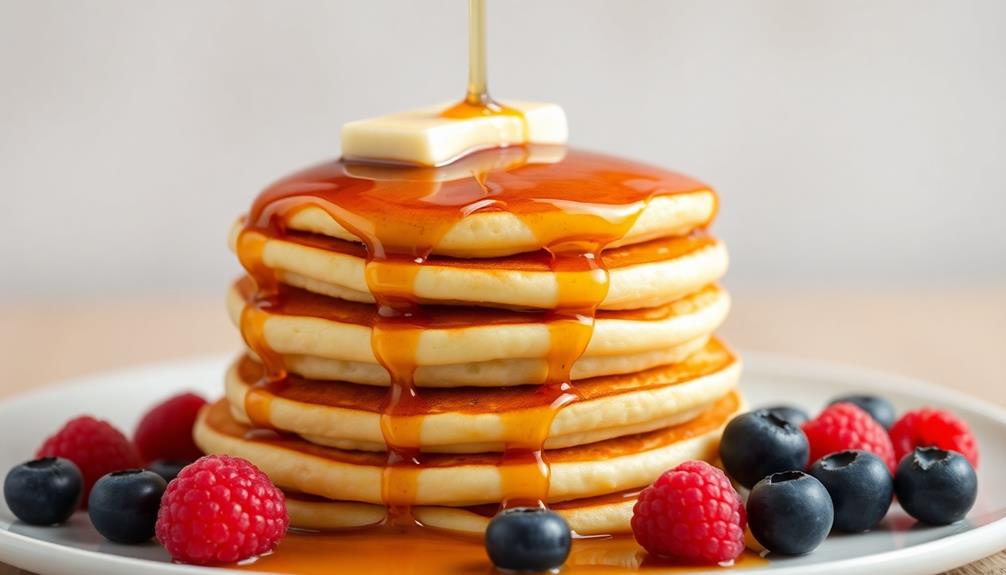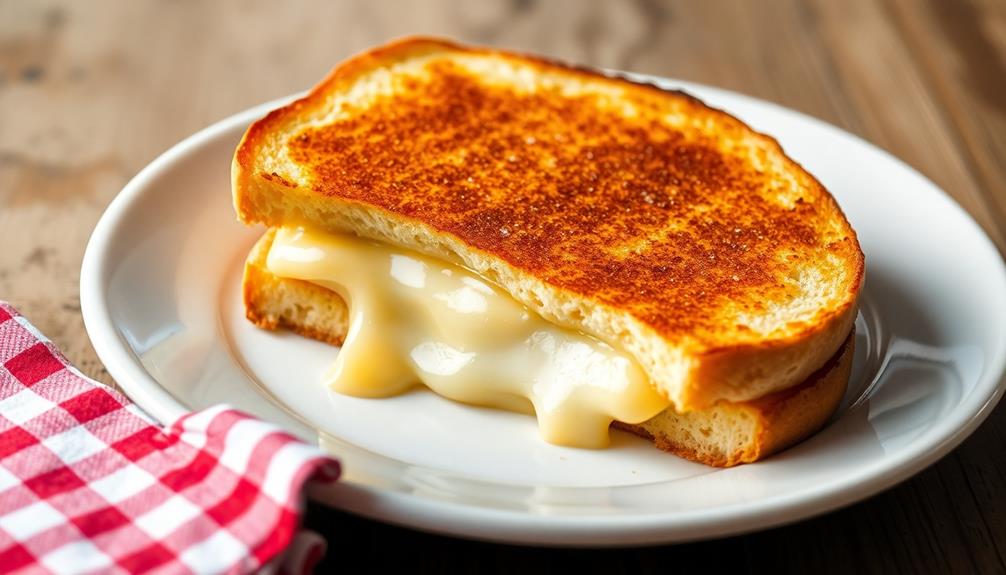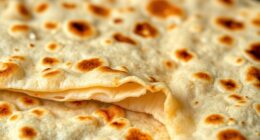You'll love the club sandwich, a classic triple-decker treat! It's packed with crispy bacon, juicy turkey, and fresh veggies between layers of toasted bread. This tasty sandwich has been around since the late 1800s and remains a favorite lunch option. To make one, you'll start by toasting bread slices until golden. Then, spread mayo, layer bacon and lettuce, add sliced turkey breast, and top with tomatoes and cheese. It's easy to customize with your favorite ingredients, making each bite unique. Get ready to dive into the world of this delicious, satisfying meal!
Key Takeaways
- Club sandwiches typically contain three layers of toasted bread with turkey, bacon, lettuce, tomato, and mayonnaise.
- Originated in the late 19th century at Saratoga Club House, New York, gaining widespread popularity in the 1920s and 1930s.
- Usually cut into quarters and secured with toothpicks, often served with sides like chips or pickles.
- Contains an average of 400-600 calories and is high in protein due to its meat content.
- Variations exist, including regional adaptations, vegetarian options, and gourmet versions with artisanal ingredients.
History
Originating in the late 19th century, the club sandwich has become a staple of American cuisine. You'll love learning about its fascinating history! It all started at the Saratoga Club House in New York, where this delicious sandwich was first created. The exact year isn't known, but it's believed to be around 1894.
The club sandwich quickly gained popularity among the wealthy members of exclusive social clubs. That's how it got its name! You might be surprised to know that the original recipe was a bit different from what we enjoy today. It had turkey, bacon, lettuce, and mayonnaise, but no tomato.
As time went on, the club sandwich spread to other parts of the country. Restaurants and hotels started adding it to their menus, and people couldn't get enough of it. The sandwich's popularity grew even more during the 1920s and 1930s.
Today, you can find club sandwiches almost everywhere in the United States. They've become a classic lunch option, loved by people of all ages. Isn't it amazing how a simple sandwich has such a rich history?
Cooking Steps
Sandwich assembly is the key to creating a perfect club sandwich.
You'll start by toasting three slices of bread until they're golden brown. Once they're ready, it's time to build your masterpiece!
On the first slice, spread some mayo and add a layer of lettuce. Next, place slices of juicy tomato on top. Then, add your first protein layer – usually turkey or chicken. Cover this with the second slice of toasted bread.
Now, it's time for the middle layer. Spread mayo on the second slice and add more lettuce. This time, you'll add crispy bacon strips and sliced avocado if you like.
Finally, add your second protein layer, often ham or more turkey.
Top it all off with the third slice of toast. To keep everything together, you'll need to secure your club sandwich.
Cut it diagonally into quarters and pierce each quarter with a long toothpick. These toothpicks not only hold the layers in place but also make your sandwich look fancy and appetizing.
Enjoy your homemade club sandwich!
Step 1. Toast Bread Slices Until Golden
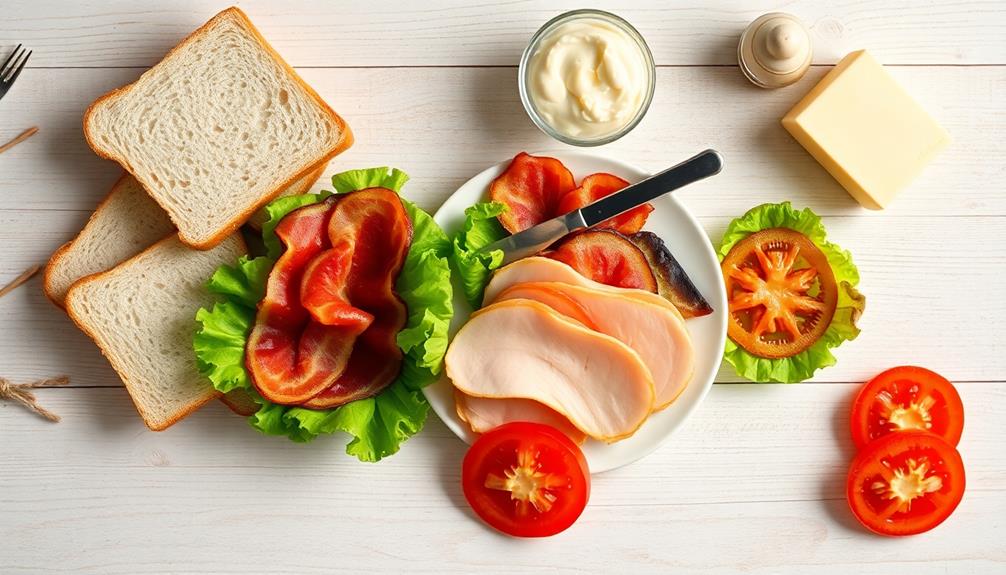
To begin assembling your club sandwich, start by toasting the bread slices. You'll want to get them nice and golden for that perfect crunch. Grab your favorite bread, whether it's white, whole wheat, or sourdough.
Pop the slices into your toaster or toaster oven and keep an eye on them. They should turn a warm, inviting color that'll make your mouth water!
While the bread is toasting, get ready for the next steps. The aroma of toasting bread will fill your kitchen, building excitement for your tasty sandwich.
Once the slices pop up, carefully remove them. They'll be hot, so be careful! Let them cool for a moment on a clean plate.
If you're feeling fancy, you can spread a thin layer of butter on the warm toast. This adds extra flavor and helps prevent the bread from getting soggy.
Now your perfectly toasted bread is ready for all the delicious layers of your club sandwich. Get ready to stack those ingredients high!
Step 2. Spread Mayonnaise on Toast
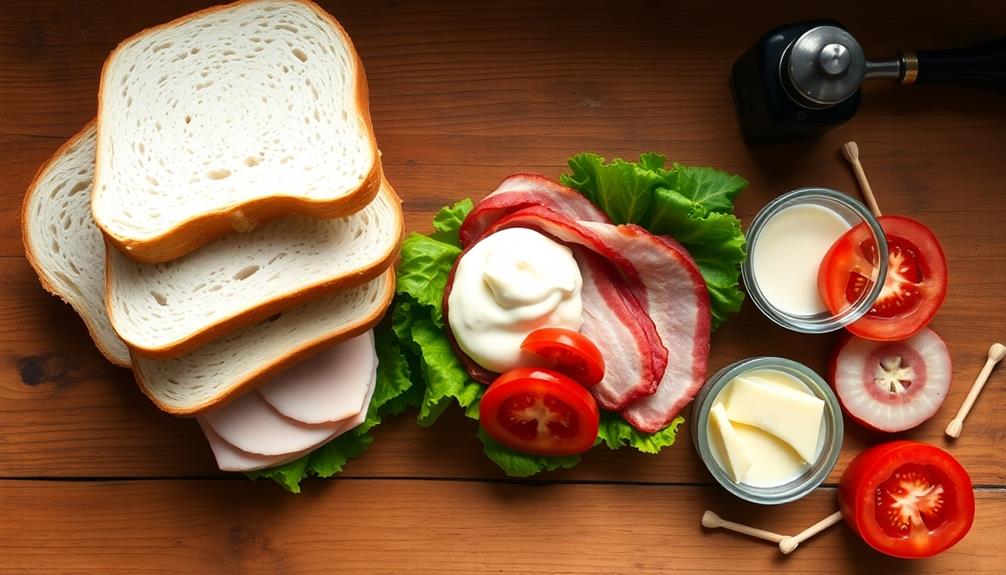
Smoothness is key as you spread a layer of creamy mayonnaise on your toasted bread slices.
You'll want to use a butter knife or spatula to get an even coating. Don't be shy with the mayo – it's what gives your club sandwich that classic, rich flavor!
Start with one side of each bread slice. Dip your knife into the mayo jar and scoop out a good dollop. Place it in the center of the toast and gently push it outwards. As you spread, make sure you're covering the entire surface, right up to the edges. You don't want any dry spots!
Once you've finished one side, flip the bread over and repeat on the other side. This double-layer of mayo will keep your sandwich moist and delicious.
If you're watching your calories, you can use a light mayo instead. But remember, a good club sandwich is all about indulgence!
Make sure you're using fresh mayonnaise for the best taste. Your perfectly mayo-coated toast is now ready for the next exciting step in creating your mouthwatering club sandwich!
Step 3. Layer Bacon and Lettuce
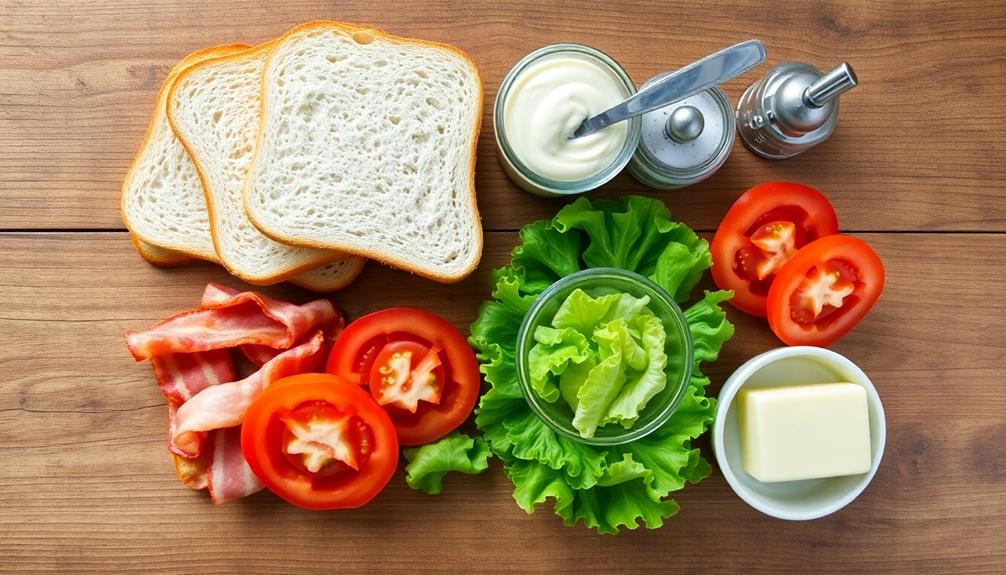
With your mayo-slathered toast ready, it's time to add the star players of your club sandwich: bacon and lettuce.
First, grab your crispy bacon strips. You'll want to use about 3 or 4 pieces for each sandwich. Lay them out evenly on one slice of toast, making sure they cover the bread from edge to edge.
Next, it's lettuce time! Choose fresh, crisp lettuce leaves. Iceberg or romaine work great for this. Rinse the leaves and pat them dry with a paper towel.
Then, tear them into pieces that fit nicely on your sandwich. Layer the lettuce on top of the bacon, creating a bed of green goodness.
Now, here's a pro tip: press down gently on the lettuce to help it stick to the mayo. This will keep your sandwich layers from sliding around when you eat it.
Step 4. Add Sliced Turkey Breast

Having layered your bacon and lettuce, it's time to add the protein powerhouse of your club sandwich: sliced turkey breast. This delicious meat will make your sandwich extra filling and tasty.
Start by choosing high-quality turkey breast slices. You'll want them to be thin and even, so they'll fit nicely in your sandwich. Take about 3 to 4 slices, depending on how meaty you like your club. Place them gently on top of the lettuce layer, making sure they cover the entire surface.
If you're feeling creative, you can fold the turkey slices into waves or ruffles. This not only looks pretty but also adds some texture to your sandwich. Don't forget to tuck in any edges that might be hanging over the bread.
For an extra flavor boost, you can spread a thin layer of mustard or mayo on the turkey. This will help it stick to the lettuce and add some zing to your sandwich.
Now you're ready for the next exciting layer in your club sandwich masterpiece!
Step 5. Add Sliced Tomatoes and Cheese
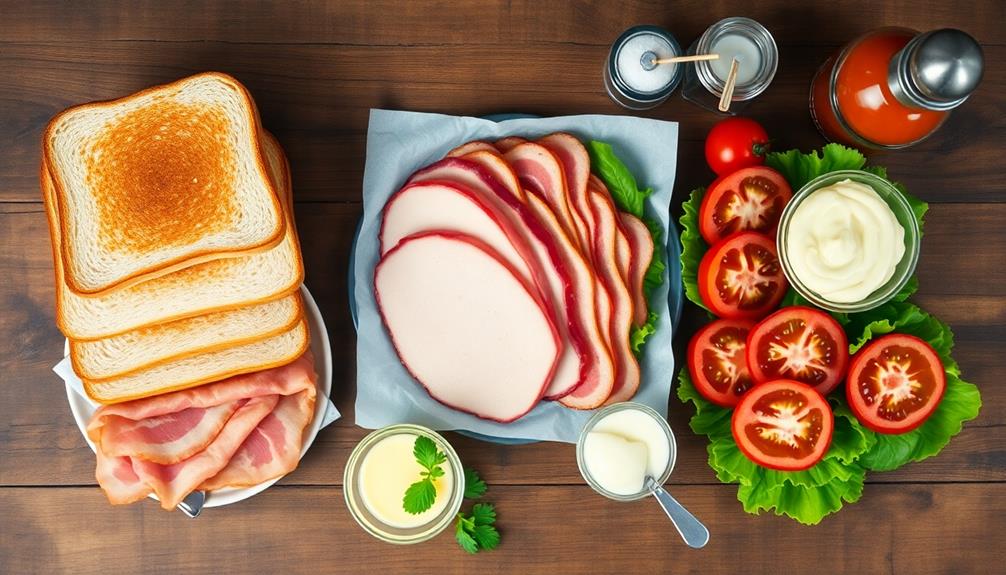
After layering the turkey, it's time to add some freshness and creaminess to your club sandwich. Grab a couple of ripe tomatoes and wash them thoroughly. Carefully slice them into thin, round pieces. You'll want about 2-3 slices per sandwich, depending on the size of your tomatoes.
Now, place these juicy tomato slices on top of the turkey. They'll add a burst of flavor and a nice, cool contrast to the meat.
Next, it's cheese time! Choose your favorite cheese – cheddar, Swiss, or provolone work great. Take 1-2 slices and layer them over the tomatoes.
The cheese will melt slightly from the warmth of the toasted bread, creating a delicious, gooey texture. If you're feeling extra hungry, you can add another layer of cheese on top of the tomatoes for a more indulgent sandwich. This dish is a perfect comfort food for a quick and easy meal. The combination of melted cheese, juicy tomatoes, and crispy bread makes for a satisfying bite every time. With this delicious grilled cheese recipe, you can enjoy a simple yet satisfying sandwich anytime.
Final Thoughts
The club sandwich stands as a timeless classic in the world of sandwiches. It's a perfect blend of flavors and textures that'll satisfy your hunger and please your taste buds.
As you build your club sandwich, remember that the key is in the layers. Each ingredient plays a crucial role in creating that perfect bite.
Don't be afraid to get creative with your club sandwich. You can swap out the turkey for chicken or ham, or even try a vegetarian version with grilled vegetables. The possibilities are endless!
Just make sure to keep the essential elements like crispy bacon, fresh lettuce, and juicy tomatoes.
When you're ready to serve your club sandwich, cut it into triangles and secure each section with a toothpick. This not only makes it easier to eat but also adds a touch of elegance to your presentation.
Pair your sandwich with some crispy potato chips or a side salad for a complete meal. Enjoy your homemade club sandwich – it's a delicious treat you can be proud of!
Frequently Asked Questions
What's the Best Bread to Use for a Club Sandwich?
You'll want to use toasted white bread for the best club sandwich experience. It's sturdy enough to hold all the fillings, yet soft enough to bite through easily. Don't forget to trim off the crusts!
Can I Make a Vegetarian Version of a Club Sandwich?
You can definitely make a vegetarian club sandwich! Try using grilled vegetables, avocado, and hummus instead of meat. Add cheese if you're not vegan. Layer your fillings between three slices of toasted bread for an authentic club experience.
How Long Can a Club Sandwich Be Stored in the Refrigerator?
You shouldn't store a prepared sandwich for more than 2-3 days in the fridge. It's best to eat it within 24 hours for optimal freshness. If you've used mayo, consume it even sooner to avoid foodborne illness.
Are There Any Low-Calorie Alternatives for a Traditional Club Sandwich?
You can try several low-calorie alternatives. Use whole grain bread, lean turkey instead of bacon, avocado instead of mayo, and load up on veggies. You'll also cut calories by skipping the third slice of bread.
What Are Some Unique Variations of the Club Sandwich Around the World?
You'll find diverse club sandwich variations globally. Try Japan's katsu sando, Mexico's club torta, or Turkey's Çılbır club. Don't miss India's chutney-spiced version or Australia's chicken schnitzel club. Each offers a unique twist on the classic.
